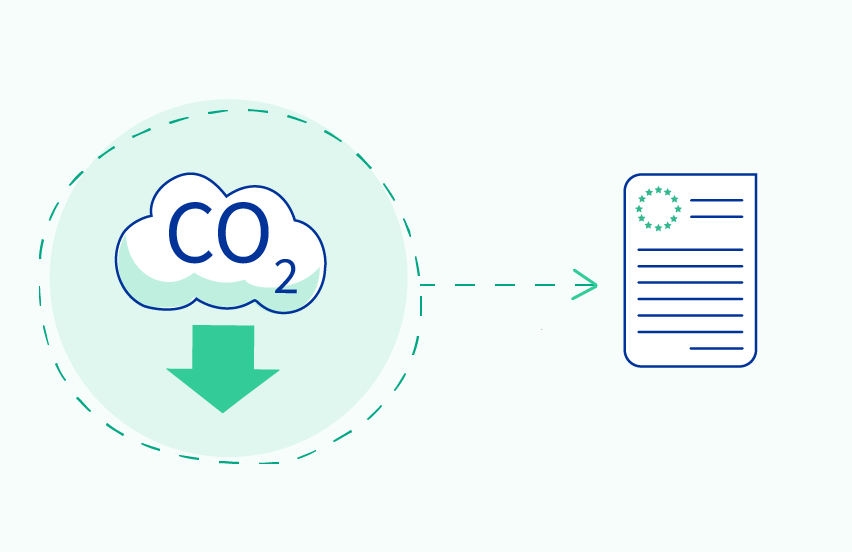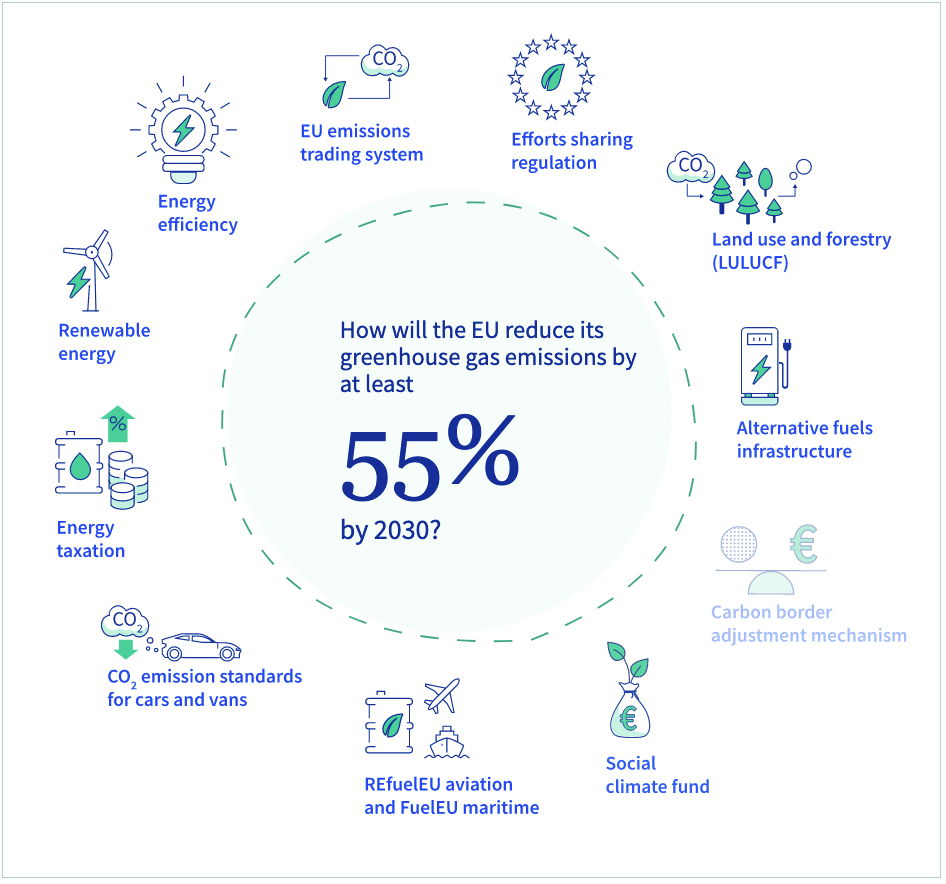What is the Fit for 55 package?

The Fit for 55 package is a set of proposals to revise and update EU legislation and to put in place new initiatives with the aim of ensuring that EU policies are in line with the climate goals agreed by the Council and the European Parliament.
Why ‘Fit for 55’?
Fit for 55 refers to the EU’s target of reducing net greenhouse gas emissions by at least 55% by 2030. The proposed package aims to bring EU legislation in line with the 2030 goal.
The package of proposals aims at providing a coherent and balanced framework for reaching the EU’s climate objectives, which:
- ensures a just and socially fair transition
- maintains and strengthens innovation and competitiveness of EU industry while ensuring a level playing field vis-à-vis third country economic operators
- underpins the EU’s position as leading the way in the global fight against climate change
The Council as co-legislator
The proposals of the Fit for 55 package are first presented and discussed at technical level within the Council’sworking parties responsible for the policy area concerned, before they land on the table of EU member states’ ambassadors in Coreper. Discussions are held to prepare the ground for an agreement on the proposals among the 27 member states.
EU member states, represented by their ministers within the Council of the EU, are responsible for adopting EU laws, based on legislative proposals presented by the European Commission. In most cases, laws are adopted together with the European Parliament following the ordinary legislative procedure.
EU ministers, in various Council configurations, then exchange views and seek to reach agreement on a common position on the proposals. This forms the basis on which the presidency of the Council then engages with the European Parliament in negotiations to find common agreement in view of the final adoption of the legislative acts.
The Fit for 55 package was submitted to the Council in July 2021 and it is being discussed across several policy areas, such as environment, energy, transport and economic and financial affairs.
What is included in the Fit for 55 package?
The Fit for 55 package is a set of proposals for new EU legislation with which the EU and its 27 member states plan to achieve the EU 2030 climate goal. It includes proposed legislation on:
- EU emissions trading system
- efforts sharing regulation
- land use and forestry (LULUCF)
- alternative fuels infrastructure
- carbon border adjustment mechanism
- social climate fund
- RefuelEU aviation and FuelEU maritime
- CO2 emission standards for cars and vans
- energy taxation
- renewable energy
- energy efficiency
EU emissions trading system

The Commission has proposed a comprehensive set of changes to the existing EU’s emissions trading system (EU ETS) that should result in an overall emission reduction in sectors concerned of 61% by 2030 compared with 2005.
The increased ambition is to be achieved by strengthening the current provisions and extending the scope of the scheme. The proposal notably aims to:
- include emissions from maritime transport in the EU ETS
- phase out free allocation of emission allowances to aviation and to the sectors that are to be covered by the carbon border adjustment mechanism (CBAM)
- implement the global carbon offsetting and reduction scheme for international aviation (CORSIA) through the EU ETS
- increase funding available from the modernisation fund and the innovation fund
- revise the market stability reserve in order to continue ensuring a stable and well-functioning EU ETS
In addition, the Commission proposes to create a new self-standing emissions trading system for buildings and road transport to support member states in meeting their national targets under the effort sharing regulation in a cost efficient way. With the proposal, emissions reductions of 43% should be achieved for these sectors by 2030, compared to 2005.
The Environment Council adopted a general approach on the revision of the EU ETS in June 2022.
- Fit for 55 package: Council reaches general approaches relating to emissions reductions and their social impacts (press release, 29 June 2022)
- Proposal on revision of EU ETS

Member states’ emissions reduction targets
The effort sharing regulation currently sets binding annual greenhouse gas emissions targets for member states in sectors that are not covered by the EU emissions trading scheme or the regulation on land use, land use change and forestry (LULUCF).
The main change the Commission has proposed to the existing legislation concerns the targets to be achieved by 2030 in those sectors. The proposal increases the EU-level greenhouse gas emissions reduction target from 29% to 40%, compared with 2005 and updates the national targets accordingly. The calculation method for determining the national targets remains based on GDP per capita with a limited amount of targeted corrections to address cost-efficiency concerns.
EU environment ministers agreed on a Council negotiating position about the revised rules on 29 June 2022.
- Fit for 55 package: Council reaches general approaches relating to emissions reductions and their social impacts (press release, 29 June 2022)
- Proposal on the revision of effort sharing regulation

Emissions and removals from land use, land use change and forestry
The Commission’s proposal aims to strengthen the contribution of the land use, land-use change and forestry (LULUCF) sector to the EU’s increased overall climate ambition. It is necessary to reverse the current declining trend of carbon removals and enhance the natural carbon sink throughout the EU. Specifically, the revision of the current legislation proposes to:
- set an EU-level target for net removals of greenhouse gases of at least 310 million tonnes of CO2 equivalent by 2030, which is distributed among the member states as binding targets
- simplify the rules on accounting and compliance and enhance monitoring
The Environment Council adopted a general approach on the revised LULUCF regulation on 29 June 2022.
- Fit for 55 package: Council reaches general approaches relating to emissions reductions and their social impacts (press release, 29 June 2022)
- Proposal on the revision of the LULUCF regulation
Renewable energy
The Fit for 55 package includes a proposal for a revision of the renewable energy directive. The proposal is to increase the current EU-level target of at least 32% of renewable energy sources in the overall energy mix to at least 40% by 2030.
It also proposes the introduction or enhancement of sectorial sub-targets and measures across sectors, with a special focus on sectors where progress with integrating renewables has been slower to date, in particular in the fields of transport, buildings and industry.
EU energy ministers agreed their joint position on the proposal for a revised EU renewable energy directive on 27 June 2022. The agreement paved the way for the Council to start negotiations with the European Parliament.
Energy efficiency
The Commission has proposed to revise the current energy efficiency directive by increasing the current EU-level target for energy efficiency from 32.5% to 36% for final, and 39% for primary energy consumption.
In addition, it put forward several provisions to accelerate energy efficiency efforts by member states, such as increased annual energy savings obligations and new rules aimed at decreasing the energy consumption of public sector buildings, as well as targeted measures to protect vulnerable consumers.
On 27 June 2022, the Council adopted its ‘general approach‘ on the proposed new rules. The next step will be negotiations with the European Parliament (trilogues).

Alternative fuels infrastructure
The Commission has presented a proposal for the revision of existing legislation aiming to accelerate the deployment of infrastructure for recharging or refuelling vehicles with alternative fuels and to provide alternative power supply for ships in ports and stationary aircraft.
The proposal concerns all modes of transport and includes targets for infrastructure deployment. It also tackles interoperability and improves user friendliness.
In June 2022, the Council agreed a common position (general approach) on the Commission’s proposal for this regulation. The next step will be negotiations with the European Parliament – so-called trilogues.
- Fit for 55 package: Council adopts its position on three texts relating to the transport sector (press release, 2 June 2022)
- Transport, Telecommunications and Energy Council (Transport), 2 June 2022

CO2 emission standards for cars and vans
Within the Fit for 55 package, the Commission proposed to revise rules on CO2 emissions for cars and vans. The proposal introduces increased EU-wide reduction targets for 2030 and sets a new target of 100% for 2035. This means in practice that from 2035 it will no longer be possible to place cars or vans with an internal combustion engine on the market in the EU.
The proposed tightened CO2 standards for cars and vans aim at supporting member states in reaching their increased national targets under the effort sharing regulation while stimulating technological innovation in the sector.
The Council adopted its general approach on the proposal in June 2022.
- Fit for 55 package: Council reaches general approaches relating to emissions reductions and their social impacts (press release, 29 June 2022)
- Proposal on CO2 emission performance standards for cars and vans

Energy taxation
The proposal for a revision of the Council directive on the taxation of energy products and electricity aims to:
- align the taxation of energy products and electricity with the EU’s energy, environment and climate policies
- preserve and improve the EU internal market by updating the scope of energy products and the structure of rates and by rationalising the use of tax exemptions and reductions by member states
- preserve the capacity to generate revenues for the budgets of the member states
The proposal is currently under discussion within the Council. In June 2022, EU finance ministers took note of the French presidency’s progress report on the revision of the energy taxation directive (ETD). Member states will continue their discussions within the Council of the EU under the Czech presidency.
- Presidency progress report on the revision of energy taxation
- Economic and Financial Affairs Council, 17 June 2022
- Proposal on the revision of energy taxation

Carbon border adjustment mechanism
The objective of the Commission’s proposal for a carbon border adjustment mechanism (CBAM) is to prevent – in full compliance with international trade rules – that the emissions reduction efforts of the EU are offset by increasing emissions outside its borders through relocation of production to non-EU countries (where policies applied to fight climate change are less ambitious than those of the EU) or increased imports of carbon-intensive products.
On 15 March 2022, the Council reached agreement on the text that will form the basis of its position in the future negotiations with the European Parliament on the carbon border adjustment mechanism.
CBAM is designed to function in parallel with the EU’s emissions trading system (EU ETS), to mirror and complement its functioning on imported goods. It will gradually replace the existing EU mechanisms to address the risk of carbon leakage, in particular the free allocation of EU ETS allowances.
- Council agrees on the Carbon Border Adjustment Mechanism (press release, 15 March 2022)
- Proposal for a carbon border adjustment mechanism

Sustainable aviation fuels
Sustainable aviation fuels (advanced biofuels and electrofuels) have the potential to significantly reduce aircraft emissions. However, this potential is largely untapped as such fuels represent only 0.05% of total fuel consumption in the aviation sector.
The ReFuelEU Aviation proposal aims to reduce the aviation sector’s environmental footprint and enable it to help the EU achieve its climate targets.
The Council agreed on a general approach for the two proposals in June 2022. Negotiations with the European Parliament, in meetings known as ‘trilogues’, will lead to the final adoption of the new EU legislation.
- Fit for 55 package: Council adopts its position on three texts relating to the transport sector (press release, 2 June 2022)
- Transport, Telecommunications and Energy Council (Transport), 2 June 2022
Greener fuels in shipping
The goal of the proposal on the use of renewable and low-carbon fuels in maritime transport (FuelEU Maritime) is to reduce the greenhouse gas intensity of the energy used on-board by ships by up to 75% by 2050, by promoting the use of greener fuels by ships. Despite progress in recent years, the maritime sector still relies almost entirely on fossil fuels and constitutes a significant source of greenhouse gases and other harmful pollutant emissions.
The Council agreed on a general approach for the two proposals in June 2022. Negotiations with the European Parliament, in meetings known as ‘trilogues’, will lead to the final adoption of the new EU legislation.
- Fit for 55 package: Council adopts its position on three texts relating to the transport sector (press release, 2 June 2022)
- Transport, Telecommunications and Energy Council (Transport), 2 June 2022

Social climate fund
The social climate fund proposal aims to address the social and distributional impact of the proposed new emissions trading system for buildings and road transport.
Based on social climate plans to be developed by the member states, the fund aims to provide support measures and investments to the benefit of vulnerable:
- households
- micro-enterprises
- transport users
The fund can also cover temporary direct income support.
EU environment ministers agreed on the Council’s negotiating position for the creation of the social climate fund in June 2022.
- Proposal on the social climate fund
- Fit for 55 package: Council reaches general approaches relating to emissions reductions and their social impacts (press release, 29 June 2022)

5 facts about the EU’s goal of climate neutrality
Fighting climate change is imperative for the future of Europe and the world. The European climate law set the EU’s objective of becoming climate-neutral by 2050 into legislation. This goal followed the commitment made by the EU and its member states on signing the Paris Agreement in 2015. What does climate neutrality mean and how does the EU plan to achieve this goal?
Source
European Council, press release, 2022-06.
Supplier
European Commission
European Council
European Union
Share
Renewable Carbon News – Daily Newsletter
Subscribe to our daily email newsletter – the world's leading newsletter on renewable materials and chemicals















